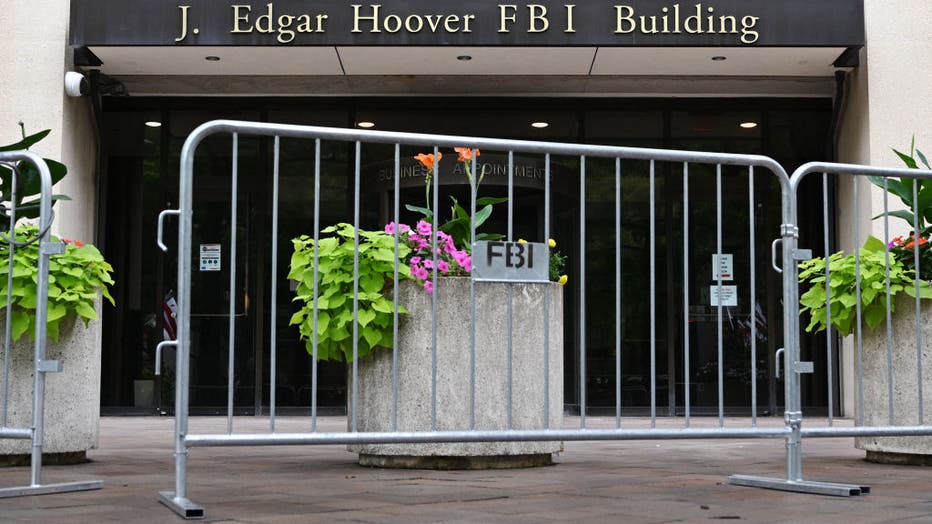FBI and Justice Department buildings briefly listed for sale before disappearing
Marjorie Taylor Greene talks DOGE
After a closed door meeting with Elon Musk and House GOP, Georgia representative Marjorie Taylor Greene discussed efforts going on in the department as well as concerns from citizens.
WASHINGTON - The Trump administration briefly listed over 440 federal buildings for sale before suddenly removing the document. The list, published Tuesday by the General Services Administration (GSA), included major properties like the FBI and Justice Department headquarters.
Hours later, a revised version removed all Washington, DC, buildings, and by Wednesday, the list was gone entirely, replaced with a "Coming soon" message. The abrupt changes have sparked speculation about the administration’s plans for federal properties.
Why was the list removed?
The backstory:
The General Services Administration published the initial list as part of a broader effort to offload federal properties it deemed "not core to government operations." The agency framed the move as a cost-cutting measure that would allow taxpayer money to be reinvested in modern office spaces.
However, after the list gained widespread attention, the GSA quickly retracted it, stating in an internal email obtained by The Associated Press that the agency had received "an overwhelming amount of interest." The email said the list would be republished later with adjustments to "make it easier for stakeholders to understand the nuances of the assets listed."
The agency also clarified that inclusion on the list did not necessarily mean a property was immediately up for sale. Instead, GSA said it would evaluate "compelling offers" and make decisions based on what is "best for the needs of the federal government and taxpayer."
What federal properties were included?
By the numbers:
The initial list covered properties in nearly every state, including major government buildings in Washington, DC, and beyond. Some of the most notable locations listed included:
- Washington, DC: FBI headquarters, Department of Justice building, Old Post Office (formerly Trump’s hotel), and the headquarters of the Department of Labor and Department of Housing and Urban Development (HUD).
- Across the US: The Major General Emmett J. Bean Federal Center (Indiana), Sam Nunn Atlanta Federal Center (Georgia), Speaker Nancy Pelosi Federal Building (California), and the US mission to the United Nations (New York).
- IRS service centers and courthouses: Facilities in Utah, Tennessee, Texas, Massachusetts, and New York were marked for potential sale.
- Civil rights landmarks: The administration also listed federal buildings named after Martin Luther King Jr. and Rosa Parks, as well as Montgomery, Alabama’s Freedom Rides Museum, which was pivotal in the civil rights movement.

FILE - Security fencing is seen outside the Federal Bureau of Investigation (FBI) headquarters in Washington, DC on August 15, 2022. (Photo by MANDEL NGAN/AFP via Getty Images)
Roughly 80% of the country's 2.4 million federal workers are based outside of metropolitan Washington, D.C.
The full scope of the government’s real estate downsizing remains unclear, but the initial list covered nearly 80 million rentable square feet of federal property. GSA estimated that selling or repurposing these buildings could save the government more than $430 million in annual operating costs.
Why is the Trump administration offloading federal properties?
The other side:
The effort to downsize the federal real estate footprint is part of a broader push by the Trump administration and billionaire Elon Musk’s Department of Government Efficiency. Officials argue that many of these properties are outdated, underused, or unnecessarily expensive to maintain.
"We are identifying buildings and facilities that are not core to government operations," GSA stated, adding that selling them "ensures that taxpayer dollars are no longer spent on vacant or underutilized federal space."
The administration has also moved aggressively to shrink the federal workforce and cut government spending. GSA regional managers were reportedly ordered to terminate as many as 300 federal office leases per day, as part of an effort to scale back government office space nationwide.
Trump has long criticized certain agencies, including the FBI and HUD, and has pushed for eliminating brutalist architecture—styles exemplified by several buildings on the list, such as the FBI headquarters.
However, critics argue that selling off key federal properties could disrupt government services, particularly in cities where these buildings play a central role in administrative and public functions.
What's next:
With the list now removed, it remains unclear whether all 440+ properties will still be considered for sale. The GSA has stated that a revised version will be published in the near future, but no timeline has been provided.
Meanwhile, the administration’s broader effort to downsize the federal government continues, with agencies reviewing thousands of leases and Musk’s Department of Government Efficiency tracking lease terminations. The uncertainty surrounding which buildings may be sold and what impact this will have on federal operations remains a pressing question.
The Source: This story was reported from Los Angeles. It is based on information from The Associated Press, which first reported on the Trump administration’s federal property disposal list and its sudden removal. Additional details were drawn from the General Services Administration’s official statements, internal emails obtained by The Associated Press.

